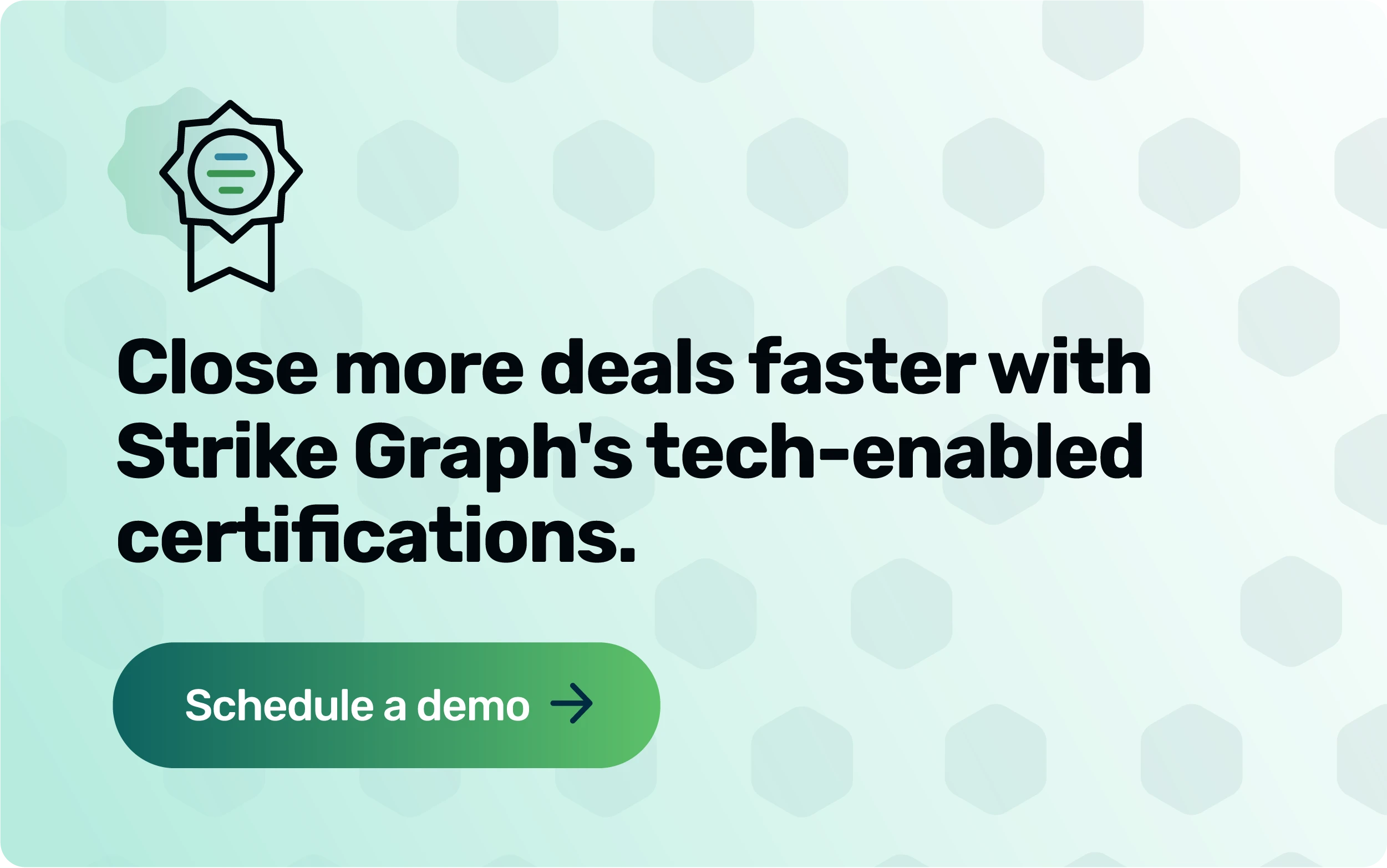The buzz around automation and AI in security compliance is pretty loud, and for a good reason. Emerging technology brings with it the promise of simpler, less stressful security processes that deliver certification, customer trust, and increased revenue for a fraction of the effort and cost of traditional security methods. Who wouldn’t be excited about that?
But here’s the thing: AI is a double-edged sword. On one side, it's brilliant at automating the mundane and sifting through mountains of data to spot security threats that might slip past human eyes. On the other, though, it can lull you into making poor strategic decisions and even introduce new vulnerabilities into your systems.
The trick is to find the sweet spot where AI and automation tools are enhancing your efforts without overshadowing the critical human insight that’s the backbone of any solid security strategy. That way, you can fully embrace the benefits of AI, making your compliance journey less burdensome while maintaining a robust security posture.
In this guide, we’ll take a look at what automation and AI do best, what’s best to leave to the humans, and how you can design a security program that’s future-proofed.
How AI and automation can boost a security program
Let’s start by looking at what AI and automation do best — and how letting technology do those tasks can benefit your security program.
Strategic security design
While humans should always be the strategic thinkers for your security program, AI technologies can provide your team the information they need to make good decisions that minimize risks to your company.
AI and automation tools excel at streamlining the process of conducting risk assessments, ensuring that potential vulnerabilities are identified and addressed with precision. And, by automating the collection and analysis of data, companies can uncover insights that might otherwise go unnoticed, allowing for a more proactive security posture.
Comprehensive — and ideally customizable — dashboards and reporting supported by automated data collection and analysis ensure that different stakeholders within an organization can focus on the data most relevant to their roles, making strategic decisions more informed and targeted. For C-suite leaders, AI-enabled data analysis provides a holistic view of an organization’s security posture, allowing for real-time adjustments and strategic planning that are responsive to the ever-changing threat landscape.
Conversational AI interfaces, like Strike Graph’s AI security assistant, provide immediate answers to security questions and keep your whole security team on the same page.
PRO TIP → See how Strike Graph’s integrated risk assessment keeps your data safe while saving time and resources.
Evidence collection
Manual evidence collection takes forever. And, there are lots of opportunities for mistakes. The use of tech integrations for automated evidence collection takes the human effort and error out of the equation.
Properly designed automation solutions dramatically reduce the time and expertise required to collect necessary evidence while maintaining stringent data protection standards. Low-code platforms, which easily integrate within existing systems, eliminate concerns about compatibility issues, offering a seamless and efficient method to gather diverse types of data and evidence. This approach decentralizes the task of evidence collection, freeing up technical resources and involving a broader team in the compliance process. By doing so, it ensures that the process is not only faster but also more inclusive, allowing for a more comprehensive and secure collection strategy.
PRO TIP → Strike Graph’s low-code integrations maximize data protection while minimizing human work.
Evidence testing and audit prediction
Two powerful new security compliance tools that artificial intelligence has given companies are evidence testing and audit prediction.
In the past, a company couldn’t know if its evidence was appropriate proof for the efficacy of its security controls until the auditor decided it was. But now, AI is capable of evaluating whether each piece of evidence is not the correct type required and also consistent with past submissions. This process not only maintains the integrity of compliance documentation but also proactively flags discrepancies, meaning companies can correct mistakes before they become a problem.
This testing technology has another important benefit — by analyzing the controls and evidence in place for each of a company’s risk factors, AI can forecast the likelihood of passing an audit, allowing organizations to preemptively address potential gaps. This predictive insight transforms audit preparation from a reactive to a proactive process, optimizing resource use and minimizing the risk of audit failure.
Tech-enabled audits mean fast certification
AI-enabled audits are revolutionizing the way security audits happen. By harnessing the power of artificial intelligence, auditors can automate much of the manual work traditionally involved in auditing processes. This shift not only accelerates the audit lifecycle but also increases the accuracy and consistency of audit outcomes. AI algorithms are capable of sifting through vast amounts of data at unprecedented speeds, identifying discrepancies, anomalies, and areas of risk that might elude human auditors.
AI-enabled audits also facilitate a more dynamic approach to compliance. Rather than being a periodic, disruptive event, audits can become an integrated, ongoing process. This real-time oversight allows for immediate corrective actions, enhancing an organization’s agility in addressing potential compliance issues.
What automation can’t (or shouldn’t) do
From AI-enabled audits to supercharged data analysis, it’s easy to see how AI is changing the way companies approach security compliance. But, it’s equally important to understand what AI and automation don’t do well.
You can't automate security compliance strategy
Due to the complex and multifaceted nature of strategic decision-making, it’s nearly impossible to automate security compliance strategy. Just think about it this way: many strategic decisions involve intricate and nuanced factors that are difficult to quantify or define precisely. Security guidelines and regulations are constantly changing, and adapting to these dynamic conditions requires continuous monitoring and adaptation. And, strategic decisions often involve dealing with uncertainty and ambiguity, as well as creative thinking and innovation — things that humans do better than AI.
Ultimately, while automation can optimize certain processes, developing, implementing, and adapting successful strategies for how your organization will deal with things like changing security requirements still depends on human judgment, ethics, and social-emotional intelligence.
Resource → Check out these 5 best practices for implementing AI into your security program
You can't automate a culture of trust
Given that a company’s culture is fundamentally tied to the people within the organization, this too simply can not be automated. After all, your company culture incorporates people’s values, beliefs, attitudes, and behaviors, which are heavily influenced by team members’ diverse backgrounds, experiences, and personalities.
At the end of the day, an effective security or TrustOps program is based on a shared understanding that building trust (through strong infosec compliance) is central to your business. Reaching this company-wide understanding requires careful communication, ongoing discussion, and shared ownership of goals and consequences — and these are things AI and automation just can’t do.
You can't automate security collaboration
Effective collaboration involves complex human interactions, communication, and teamwork as team members share ideas and build relationships. As we noted above, human dynamics such as trust, empathy, emotional intelligence, and creativity are simply impossible for AI or automation to replicate. And security (or TrustOps) programs require lots of collaboration to be successful!
What technology can do is support collaboration through smart communication tools, project management platforms, and collaborative software, for example. In other words, your people can use automated tools to make their collaboration even more successful, effective, and efficient — like automated evidence collection for an upcoming security audit or certification.
You can’t automate trust
Which all brings us to our most important point: You can't automate trust — which is what security certifications are all about.
Trust is a complex and multifaceted human emotion that is built on a combination of factors and deeply rooted in human psychology, social interactions, and experiences. AI not only lacks the ability to understand and interpret the nuances of human subjectivity but also doesn’t have the capacity to discern contextual understanding, non-verbal cues, or ethics.
While you can’t automate trust, what you can do is automate tools to facilitate trust building. For example, while you’ll always need your people to understand the reasons for and significance of a TrustOps/security program — that your company values data security and privacy and has taken the appropriate measures to ensure the safety of the data it handles — you can use automated tools to make the design, operation, and management of such a program easier.
How AI and automation can break a security program
Using AI and automation for the tasks above will ultimately undercut your security program — even if you think it will save you time in the short run. Let’s take a closer look at why this is.
Under-planning
The availability of automation and AI can trick security and TrustOps leaders into thinking they don’t need to plan strategically. There are lots of reasons that this can feel tempting:
- A lack of understanding: Business leaders may find it intimidating to try to understand the intricacies of security regulations and frameworks.
- Overconfidence in technology: Leaders — particularly those in the IT world — may come to rely too strongly on automated tools.
- A focus on short-term gains: In pursuit of quick results, business leaders may prioritize immediate security concerns without considering their longer-term security needs and goals.
Without a strong road map toward a mature, holistic TrustOps or security program, companies become lost in a maze of inefficient and disconnected security tasks. You’ll end up missing audit dates, delaying certifications, getting non-conformity letters, or worse — not having enough resources available to protect against a data breach or security incident if and when one occurs.
Relinquishing control
Relying too heavily on automation can lead companies to simply “turn on” their controls and assume the tool will take care of the rest. Control owners lose the context of what their security controls actually are, how they operate, and if they're successfully protecting them against risk. When it comes time for an audit, they’re unable to articulate the basic functionality of their security program.
Data vulnerability
The main point of a security program is — you guessed it — to make your data more secure. But poorly-designed integrations can actually make your data less secure.
- More entry points — Excess integrations can create additional entry points for attackers to exploit.
- Systems mismatch — If integrations aren’t fully compatible with your existing systems, they can open security gaps.
- Misconfiguration — If integrations aren’t implemented properly, they can grant excessive permissions, expose sensitive data, or disable critical security features, leading to data leakage or unauthorized access to sensitive information.
- Failure to update — If integrations aren’t regularly updated (and they usually aren’t, unless there’s a strong human team in play), they can become susceptible to new security threats.
- Blind spots — Since integrations don’t live on your home system, they can be blind spots that prevent you from planning for emerging security threats and/or detecting security breaches.
Security as an afterthought
Last but not least, over-automation signals both internally and externally that your organization's security program is an afterthought. Internally, this may lead to the neglect of human-centric security measures — such as security training, awareness, and employee engagement — and therefore a lack of knowledge and accountability regarding security practices among employees.
Externally, over-automation may cause a lack of transparency when it comes to security practices, which can erode trust and confidence in the organization's ability to protect sensitive information. Limited security measures, weak authentication methods, inadequate data protection practices, and/or an increased susceptibility to breaches resulting from data vulnerability can also signal to customers, partners, and stakeholders alike that security simply isn’t a priority for your organization — and that their information isn’t safe with your business.
Get started
Ready to put AI and automation to work in all the right ways? Our security experts are waiting to show you the cutting-edge AI tools available within the Strike Graph platform. Schedule a demo now.
.jpg?width=1448&height=726&name=Screen%20Shot%202023-02-09%20at%202.57.5-min%20(1).jpg)







